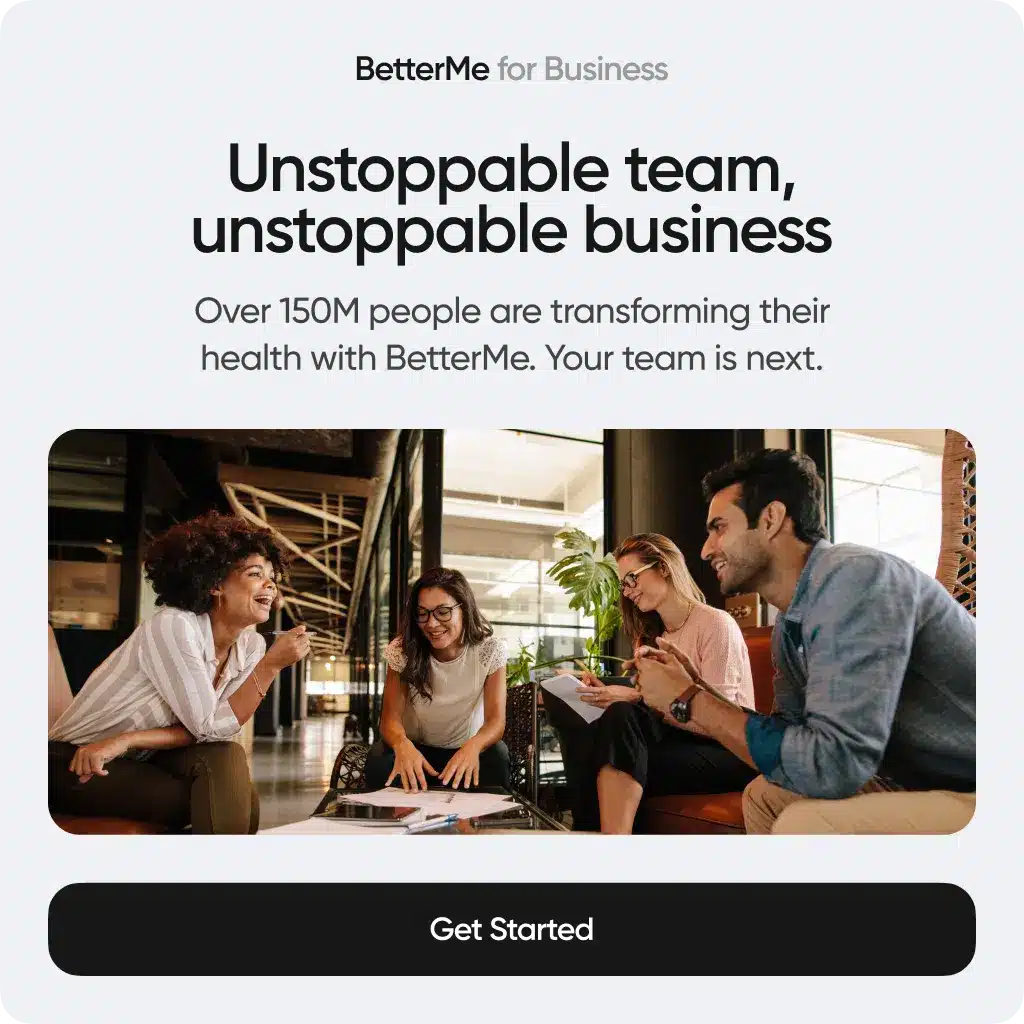Research has shown that almost 43% of Americans abandon their fitness resolutions by the end of January (1).
We’ve all been there – you get back to work after the holidays and find yourself buried under a pile of emails, meetings, and deadlines, and suddenly, the resolution to hit the gym every day becomes a distant memory.
The reality is that maintaining healthy habits at work can be challenging. Long hours sitting at a desk, stress, and workplace culture can all contribute to an unhealthy lifestyle (2). This is why World Well-Being Week is an excellent moment to reimagine how we approach employee wellness.
Wellness challenges, when strategically aligned with business goals such as reducing sick days or improving net promoter score (NPS), can also deliver measurable outcomes that benefit both employees and the company.
In this post, we explore 5 thoughtful wellness initiatives that employers can implement to inspire sustainable, healthy habits that energize teams long after the celebrations have ended.
Why Is World Well-Being Week Important to Celebrate?
World Well-Being Week is an important opportunity for organizations to reflect on the value of prioritizing employee wellness. It serves as a dedicated time to acknowledge that well-being is multifaceted and encompasses physical, emotional, and social needs (3).
Employees perform best when they feel supported and valued (4), but maintaining a focus on well-being throughout the year often takes a back seat to other demands.
By celebrating this week, companies can highlight wellness initiatives, open dialogues about workplace culture, and encourage small, meaningful shifts that can enhance the everyday experiences of employees (3).
While a single week won’t solve systemic issues, it can act as a catalyst, inspiring ongoing efforts to build a workforce that thrives.
To ensure these initiatives are effective, companies can link them to clear metrics. For example, using a KPI dashboard to track participation and engagement helps demonstrate how wellness efforts contribute to broader business performance.
BetterMe has excellent tools for your business all in one place: a personalized approach to health and wellness, 1,500 workouts for every fitness level, a variety of meal plans and trackers to satisfy any dietary needs, mental health guides, and employer support. Discover all the options now!
What Are Some Workplace Wellness Challenges for World Well-Being Week?
Here are five workplace wellness challenge ideas aligned with different dimensions of employee well-being. Each one offers a unique way to celebrate World Well-Being Week while promoting a thriving workforce.
- Physical Wellness Challenge: Get Moving Together
Physical health challenges have long been a staple of workplace wellness initiatives, but the key is to go beyond surface-level activities such as step tracking. A well-designed physical challenge supports movement while encouraging participation from people at every activity level.
Innovative ideas include:
1. Steps/Walking Challenge
Encourage employees to track their steps over a week. Use wearables or smartphone apps to create friendly competition between teams or departments. Set achievable goals based on averages and recognize milestones to maintain engagement.
2. Deskercise Breaks
Short, desk-friendly exercises are perfect for remote or in-office teams. These exercises target posture and alleviate the strain of long hours in a sedentary position (5). For example, set a daily “deskercise hour” where employees perform stretches or body-weight exercises.
3. Active Meetings
Encourage walk-and-talk meetings instead of sitting in a conference room. Walking can spark creativity and improve mood (6), which makes it ideal for small team discussions. For remote teams, encourage pacing while on audio-only calls.
Each of these activities promotes both physical and mental health, as movement directly influences energy levels and cognitive clarity.
- Mental Well-Being Challenge: Mindfulness Made Simple
Mental health is increasingly recognized as an essential component of workplace wellness (7). However, mental well-being challenges must be approachable, inclusive, and relevant to daily workplace stressors. The goal isn’t perfection but to provide employees with practical tools for managing stress and finding balance.
Innovative ideas include:
1. Mindfulness Marathons
Encourage employees to set aside 10-15 minutes of their workday to engage in mindful practices such as meditation or deep breathing. Provide guided resources via apps, videos, or live sessions. Participation doesn’t have to be rigid and it should accommodate individual schedules.
2. Digital Detox Days
Create an optional “unplug” challenge where employees reduce non-essential electronic communication for a set period. Examples include turning off email notifications for an hour or engaging in a device-free lunch break. This improves focus and helps employees disconnect from constant digital demands.
3. Gratitude Journaling
Encourage employees to write down three things they’re grateful for each day. Pair this activity with a digital gratitude wall where co-workers can share positive interactions or achievements. This small exercise can enhance perspective and build a sense of community.
While these challenges don’t eliminate stress entirely, they introduce helpful routines employees can take with them beyond Well-Being Week.
Read more: 10 Summer Wellness Activities for Employees to Stay Energized
- Nutritional Wellness Challenge: Eat Smart, Stay Energized
The food we eat tends to have an almost immediate, as well as long-term, impact on physical and emotional wellness (8). However, in the fast-paced work culture of today, it’s easy to resort to unhealthy eating habits due to convenience or lack of time.
As part of Well-Being Week, companies can guide employees toward nutritional awareness.
Innovative Ideas include
1. Recipe Relay
Organize a healthy recipe-sharing contest where employees submit nutritious meal ideas. Colleagues can vote for their favorites, and winners can be highlighted in a company newsletter or virtual cooking session. This initiative sparks creativity and offers practical meal-planning inspiration.
2. Hydration Goals
Set up a water intake challenge with individual or team participation. Employees use apps to track their daily intake with the aim of meeting personalized hydration goals. Highlight the benefits of hydration, such as improved focus and energy, to encourage enthusiasm.
3. Healthy Lunch Photo Challenge
Encourage employees to share photos of their homemade or healthy takeout lunches on social media using a designated hashtag. This friendly competition can motivate employees to make healthier choices and give them ideas for new meals.
- Financial Wellness Challenge: Wallet Fix-Up
Financial stress can be a major barrier to health and productivity (9). Addressing financial literacy as part of a wellness initiative provides employees with practical tools to reduce financial strain.
1. Budgeting Basics Workshop
Organize a short workshop or webinar to teach foundational budgeting skills, goal-setting, or saving strategies. Consider working with a financial advisor to offer individualized advice as part of the program.
2. Savings Competitions
Set small-scale savings goals and track progress as a team. This could involve a month-long commitment to reduce unnecessary spending or identify opportunities for cost-saving behaviors.
Financial wellness initiatives often extend beyond the workplace, empowering employees to feel more financially stable in their personal lives.
- Social Wellness Challenge: Building Connections
Social connection is a core human need (10), but it’s sometimes overlooked in work environments, particularly with remote or hybrid structures in play. Social challenges can foster engagement, boost camaraderie, and create shared experiences that employees will remember (11).
1. Team Treasure Hunts
Plan a scavenger hunt that gets people working together. Use physical spaces for in-person groups or flexible, online platforms for virtual hunts. Each clue or task can tie back to wellness themes, which adds an educational aspect.
2. Peer Recognition Challenges
Create a challenge that encourages peer-to-peer recognition. For example, employees can submit notes praising coworkers for their helpful contributions. Prizes or shout-outs for the most recognized individuals can build a culture of appreciation.
3. Virtual Coffee Chats
For remote teams, encourage informal one-on-one chats between paired colleagues. Rotate pairs throughout the week to expose employees to new team members. Activities like these improve morale and strengthen team relationships, even across screens.
By emphasizing connection over competition, these challenges strike a balance between fun and meaningful interactions.
What Are the Benefits of Workplace Wellness Challenges?
The potential benefits of such initiatives include:
Encouraging Employee Engagement and Morale
Wellness challenges for employees have the potential to foster a sense of connection and motivation among employees. When they’re thoughtfully designed, they can make employees feel valued and invested in by their organization (12).
Programs that incorporate teamwork, such as step competitions or recipe share challenges, may encourage collaboration and camaraderie. These interactions could help strengthen workplace relationships, which are often linked to improved engagement (13).
Employees who feel their well-being is supported are sometimes more likely to develop a stronger sense of belonging, which may contribute to greater job satisfaction (14).
Companies that tie wellness programs to core business goals tend to see better “utilization” or active employee participation.
For example, challenges that are designed around movement, mindfulness, or financial health – particularly those with team-based formats or individual flexibility – often achieve the highest levels of engagement across industries.
Supporting Physical and Mental Health
Wellness challenges for the workplace are often aimed at promoting healthier habits. If they’re appropriately tailored to employees, such initiatives can have a positive influence on physical and mental health over time (12).
For physical health, activities such as walking meetings or hydration tracking may encourage employees to adopt small, meaningful lifestyle changes. These shifts could help reduce the risks that are associated with inactivity, such as low energy levels or postural discomfort (2).
Mental wellness challenges in the workplace such as mindfulness exercises or digital detox initiatives may help participants manage stress or improve their focus (15). While they’re not a substitute for formal mental health care, these activities can complement broader efforts to support employee mental health.
It’s important to acknowledge that not everyone’s health will improve as a direct result of participation. Factors such as accessibility, individual commitment, and the design of the challenge itself all play a role.
Helping Employees Manage Stress and Build Resilience
Some workplace wellness challenges aim to equip employees with skills or tools that may help them handle stress better. Over time, this may contribute to resilience, which refers to an individual’s ability to adapt to setbacks (16).
For example, mindfulness or guided breathing challenges can provide opportunities for employees to take a break and reset during stressful periods. Adjusting workplace norms to accommodate such practices may further support stress reduction efforts (16).
If resilience gains occur, they often develop gradually as part of a workplace environment that actively supports well-being. These benefits are more likely to materialize in workplaces where participation feels voluntary and supported rather than obligatory.
Fostering Social Connections
Workplace wellness challenges, particularly those built around group activities, have the potential to enhance social bonds among employees (17).
Team-oriented challenges such as virtual scavenger hunts or peer recognition programs could facilitate collaboration and informal interaction among colleagues. This may help create stronger workplace relationships in some cases (18).
For employees who work in hybrid or remote settings, structured social challenges may help mitigate feelings of isolation. However, achieving this will require careful planning to ensure the challenges are inclusive and accessible to all participants.
It’s worth noting that while social challenges can be a tool for connection, they’re not a guaranteed solution to deeper organizational issues related to isolation or culture.
Offering Cost-Saving Possibilities
Investing in wellness challenges may contribute to cost savings in certain circumstances. For example, employees who adopt healthier habits may experience fewer health-related issues, which could reduce absenteeism or healthcare claims in the long term (19).
- Programs promoting movement, hydration, or fitness may reduce the likelihood of chronic illness if employees engage with them consistently.
- Although these potential savings are promising, they’re heavily dependent on the scale and nature of the wellness challenge, in addition to the level of employee buy-in.
Workplace challenges alone are unlikely to drive significant cost reductions unless they’re part of a broader, well-integrated wellness strategy.
Demonstrating a Commitment to Employees
When wellness challenges are implemented thoughtfully, they can signal that an employer values its workforce beyond their productivity. This perception can create positive feelings toward the organization (20).
Employees who feel supported in their well-being may be more likely to develop loyalty to their company (21). This could improve retention rates or enhance the organization’s reputation as an employer.
However, a mismatch between organizational promises and the practical execution of wellness programs could erode trust. Transparent communication and a genuine commitment to employee well-being are critical for long-term success.
Promoting Personal Growth and Awareness
Wellness challenges may offer employees an opportunity to reflect on their habits and identify areas for improvement. For some participants, this may lead to small but meaningful personal development.
- Participation in challenges such as gratitude journaling or healthier eating may inspire individual employees to make lasting changes to their daily routines.
- Over time, these shifts could support greater confidence and focus, which may have positive effects on both personal and professional aspects of life.
It’s important to keep in mind that participation and personal growth are highly individual. No single challenge will resonate equally with all employees.
How to Adapt Workplace Wellness Challenges for All Fitness Levels
To ensure workplace wellness challenges are inclusive, you should tailor activities to accommodate diverse needs and abilities.
Offer multiple difficulty levels, allow employees to choose their preferred pace, and include options that are focused on activities unrelated to physical exertion, such as mindfulness or hydration goals.
For example:
- Provide step challenges with tiered goals (e.g. 5,000, 7,500, or 10,000 steps daily).
- Offer seated exercise options for employees with mobility limitations.
- Include non-physical challenges, such as gratitude journaling or hydration tracking.
- Create team-based walking challenges, where group efforts combine for a shared goal.
BetterMe provides members with tailored plans that are based on their unique physical, psychological, and lifestyle needs and health goals. Start using BetterMe corporate wellness solutions to transform your team and business!
What Are Good Options for Hybrid and Remote Teams?
For hybrid and remote teams, prioritize challenges that are easy to track digitally and inclusive of diverse time zones. Digital platforms and collaborative tools can help bridge geographical gaps, fostering a sense of community even across distances.
For example:
- Organize virtual scavenger hunts using shared work tools.
- Launch online step-tracking challenges that are tied to fitness apps.
- Host virtual mindfulness sessions or guided meditation breaks.
Read more: Top 10 Stress-Relief Activities to Organize for Your Team During Stress Awareness Month
How Can You Ensure Participation Without Pressure?
Participation can be encouraged by framing challenges as enjoyable, voluntary opportunities rather than obligations. Clearly communicate that these activities are meant to enhance well-being and offer flexibility in terms of time and effort required.
You can further encourage participation without pressure if you:
- Use opt-in registration to make participation voluntary.
- Reward effort, not performance, through participation-based incentives.
- Use regular shoutouts to celebrate milestones or progress, regardless of the overall results.
- Allow employees to opt for private reporting of their progress to maintain comfort and confidentiality.
Most wellness challenges work best when they last between two and six weeks. This timeframe is long enough to build habits but short enough to maintain engagement. Research has shown that building a routine typically takes about 21 days (22), which makes challenges in this range more likely to stick. These activities are simple to implement and inclusive of various fitness and wellness levels. Yes, many wellness challenges can be implemented with little to no cost. Examples include using free apps for step tracking, encouraging peer-led activities such as walking meetings, or hosting virtual gratitude walls for sharing positive interactions. The key is the creative use of existing resources to engage employees. Measuring impact involves both qualitative and quantitative approaches.Frequently Asked Questions
How long should a wellness challenge last?
What are some easy wellness ideas to start with?
Can wellness challenges be low-cost or free?
How do you measure the impact of these initiatives?
The Bottom Line
When designed thoughtfully, workplace wellness challenges can make a lasting impact during World Well-Being Week 2025. Instead of generic initiatives, tailor activities that inspire participation and create opportunities for growth. Whether it’s physical movement, mindfulness, better eating habits, or social engagement, these challenges invest in the holistic wellness of employees.
By keeping the challenges flexible and inclusive, you’ll ensure solutions that suit diverse needs and schedules. And most importantly, you’ll foster a workplace culture that prioritizes health – not just for a week, but for the long term.
When combined with clear KPIs, thoughtful launch planning, and alignment with business outcomes such as reduced sick leave or improved employee satisfaction (e.g. NPS), they can yield both personal and organizational wins.
DISCLAIMER:
This article is intended for general informational purposes only and does not serve to address individual circumstances. It is not a substitute for professional advice or help and should not be relied on for making any kind of decision-making. Any action taken as a direct or indirect result of the information in this article is entirely at your own risk and is your sole responsibility.
BetterMe, its content staff, and its medical advisors accept no responsibility for inaccuracies, errors, misstatements, inconsistencies, or omissions and specifically disclaim any liability, loss or risk, personal, professional or otherwise, which may be incurred as a consequence, directly or indirectly, of the use and/or application of any content.
You should always seek the advice of your physician or other qualified health provider with any questions you may have regarding a medical condition or your specific situation. Never disregard professional medical advice or delay seeking it because of BetterMe content. If you suspect or think you may have a medical emergency, call your doctor.
SOURCES:
- A large-scale experiment on New Year’s resolutions: Approach-oriented goals are more successful than avoidance-oriented goals (2020, pmc.ncbi.nlm.nih.gov)
- Long working hours and risk of 50 health conditions and mortality outcomes: a multicohort study in four European countries (2021, sciencedirect.com)
- Why World Wellbeing Week is an opportunity for us all to celebrate the many aspects of wellbeing (2023, defradigital.blog.gov.uk)
- Impact of Employees’ Workplace Environment on Employees’ Performance: A Multi-Mediation Model (2020, frontiersin.org)
- Editors’ Desk – Creating a Movement for Healthy Physical Activity at Work (2023, pmc.ncbi.nlm.nih.gov)
- Acute and Chronic Physical Activity Increases Creative Ideation Performance: A Systematic Review and Multilevel Meta-analysis (2022, sportsmedicine-open.springeropen.com)
- Mental well-being at the workplace (2010, pmc.ncbi.nlm.nih.gov)
- Nutrition and Mental Well-Being: Exploring Connections and Holistic Approaches (2023, mdpi.com)
- The Impact of Financial Stress on Employee Performance, Workplace Productivity, and Mental Health (2024, enrich.org)
- What is the importance of social connection? (n.d., hhs.gov)
- Do work relationships matter? Characteristics of workplace interactions that enhance or detract from employee perceptions of well-being and health behaviors (2014, tandfonline.com)
- What do Workplace Wellness Programs do? Evidence from the Illinois Workplace Wellness Study* (2019, pmc.ncbi.nlm.nih.gov)
- What Is Employee Engagement and How Do You Improve It? (n.d., gallup.com)
- The Role of Workplace Well-Being on Employee Work Satisfaction (2023, researchgate.net)
- Types of Digital Mindfulness: Improving Mental Health Among College Students – A Scoping Review (2024, pmc.ncbi.nlm.nih.gov)
- Mindfulness-Based Resilience Training in the Workplace: Pilot Study of the Internet-Based Resilience@Work (RAW) Mindfulness Program (2018, jmir.org)
- Social Connectedness: Building Bonds in the Workplace (2023, businessgrouphealth.org)
- We know teamwork is important, but how important? (2020, your.yale.edu)
- Healthy employees are more productive (2024, cignaglobalhealth.com)
- The science of happiness at work: How positive psychology can increase productivity (2023, lpsonline.sas.upenn.edu)
- The Holistic Model of Labour Retention: The Impact of Workplace Wellbeing Factors on Employee Retention (2023, mdpi.com)
- Time to Form a Habit: A Systematic Review and Meta-Analysis of Health Behaviour Habit Formation and Its Determinants (2024, mdpi.com)













